| |
|
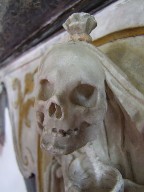 |
|
I always forget how hilly
this part of Suffolk is, where the last
gasp of the Chilterns lifts its head
between the Stour Valley and Newmarket
Heath. I was also close to the
Cambridgeshire border, which winds in a
most curious way around the town of
Newmarket, so that you find
Cambridgeshire villages to the east of
Suffolk ones, and so on. It can be a
little confusing if you aren't an East
Anglian, I expect.
And the villages around here
are very pleasant; Wickhambrook is to the south,
lovely Lidgate just off to the
west, and the rich, horsey Cambridge
commuter belt of Gazeley, Moulton and Dalham to the north. I
was surprised just how big Ousden was as
I followed the road that my map said led
to the church. At first, I thought I had
found it, but it turned out to be a
modern cemetery with a lychgate. The road
descended steadily, and I was wary of
shooting straight past, and then having
to cycle back up the hill again. The
slope went on and on, and after about a
mile, and just when I though that I must
have missed it, and would fall off the
edge into Cambridgeshire, there it was,
St Peter, in a beautiful setting in the
grounds of the Hall.
A track leads up to the
church past a large dovecote in a field
to the east. I pushed my bike through the
churchyard gate. To the right of the
entrance was a little fenced off area,
against the Hall hedge. The 19th century
graves it contained must be for members
of the former family there.
|
St
Peter is that rare beast in Suffolk, a cruciform
church. The Norman tower is also unusual, because
it seems to have been very little altered over
the centuries, common enough in other counties,
but rare in Suffolk. As ancient as the chancel
is, there must have been an earlier one, for the
former roofline shows on the east face of the
tower, at the same height as the nave. Beyond the
church, the graveyard is fenced off for sheep to
graze, but you can climb over and take a look at
the south side which is equally interesting and
lovely, with a rather extraordinary north
doorway, and a memorial to Peragrine Clackett.
Mortlock thought that the Victorians had extended
the nave, but it is all done very well indeed. A
pretty little 18th century chapel, which Mortlock
tells us was the family pew for the Hall, is the
finishing touch.
The
Norman tower and chancel arches are solid
affairs, quite different to the fey Decorated and
Perpendicular architecture found in most of the
county. It is worth taking a close look, since
there are a number of unusual carvings on them.
Ousden
is most famous for its memorial to Laeititia
Moseley, which features Suffolk's finest and
scariest skeleton. She wears her shroud and grins
wildly. Quite what generations of Ousden children
have made of her I couldn't say, but I bet she
has been the catalyst for more than a few bad
dreams.
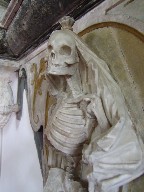 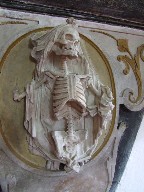 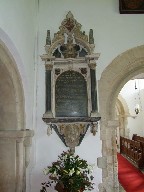
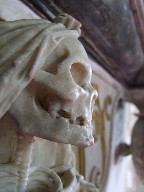
Laeititia
died in 1619, and her inscription above her
skeleton reads, in part:
| |
|
|
Three
tymes five yeares a virgins lyfe she
tryed;
three tymes ten yeares a wyfe & then
she dyed.
of Daughters seven, sonnes three she was
the Mother,
To poore and rich a freind, they all did
love her,
who at her Death rejoyct, & yet were
sorrye,
Sad to recount her losse, glad for her
glorye. |
| I love
stepping into churches like this - they
are so out of the ordinary. I always
think it must be very curious to worship
in one, since there is a sense in which
the church is actually three separate
buildings that just happen to be joined
together. Sometimes, this feeling is
alleviated by enlarged archways, as at Pakenham, but here, the low
Norman arches survive into the area
beneath the tower, making the vistas very
tight and narrow. It is a salutary
reminder that the nave and chancel were
built for different purposes, and not for
congregational Anglican worship at all. This is a lovely
church, full of interest. It was well
worth the long climb back into the
village afterwards.
|
|
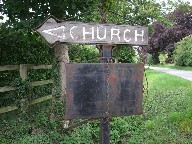 |
|
|
|

